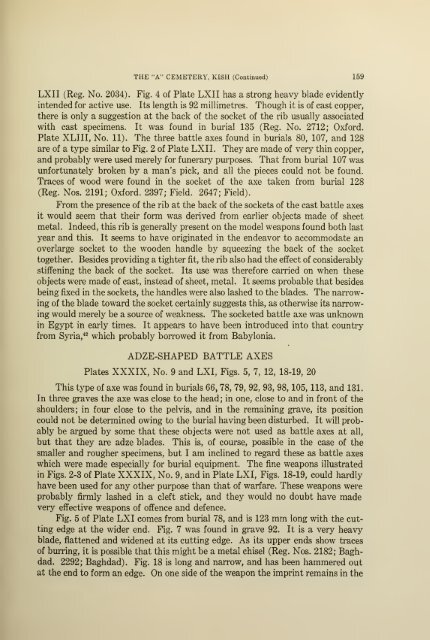A Sumerian Palace and the "A" cemetery at Kish, Mesopotamia
A Sumerian Palace and the "A" cemetery at Kish, Mesopotamia
A Sumerian Palace and the "A" cemetery at Kish, Mesopotamia
You also want an ePaper? Increase the reach of your titles
YUMPU automatically turns print PDFs into web optimized ePapers that Google loves.
THE "A" CEMETERY, KISH (Continued) 159<br />
LXII (Reg. No. 2034). Fig. 4 of Pl<strong>at</strong>e LXII has a strong heavy blade evidently<br />
intended for active use. Its length is 92 millimetres. Though it is of cast copper,<br />
<strong>the</strong>re is only a suggestion <strong>at</strong> <strong>the</strong> back of <strong>the</strong> socket of <strong>the</strong> rib usually associ<strong>at</strong>ed<br />
with cast specimens. It was found in burial 135 (Reg. No. 2712; Oxford.<br />
Pl<strong>at</strong>e XLIII, No. 11). The three b<strong>at</strong>tle axes found in burials 80, 107, <strong>and</strong> 128<br />
are of a type similar to Fig. 2 of Pl<strong>at</strong>e LXII. They are made of very thin copper,<br />
<strong>and</strong> probably were used merely for funerary purposes. Th<strong>at</strong> from bui'ial 107 was<br />
unfortun<strong>at</strong>ely broken by a man's pick, <strong>and</strong> all <strong>the</strong> pieces could not be found.<br />
Traces of wood were found in <strong>the</strong> socket of <strong>the</strong> axe taken from burial 128<br />
(Reg. Nos. 2191; Oxford. 2397; Field. 2647; Field).<br />
From <strong>the</strong> presence of <strong>the</strong> rib <strong>at</strong> <strong>the</strong> back of <strong>the</strong> sockets of <strong>the</strong> cast b<strong>at</strong>tle axes<br />
it would seem th<strong>at</strong> <strong>the</strong>ir form was derived from earlier objects made of sheet<br />
metal. Indeed, this rib is generally present on <strong>the</strong> model weapons found both last<br />
year <strong>and</strong> this. It seems to have origin<strong>at</strong>ed in <strong>the</strong> endeavor to accommod<strong>at</strong>e an<br />
overlarge socket to <strong>the</strong> wooden h<strong>and</strong>le by squeezing <strong>the</strong> back of <strong>the</strong> socket<br />
toge<strong>the</strong>r. Besides providing a tighter fit, <strong>the</strong> rib also had <strong>the</strong> effect of considerably<br />
stiffening <strong>the</strong> back of <strong>the</strong> socket. Its use was <strong>the</strong>refore earned on when <strong>the</strong>se<br />
objects were made of cast, instead of sheet, metal. It seems probable th<strong>at</strong> besides<br />
being fixed in <strong>the</strong> sockets, <strong>the</strong> h<strong>and</strong>les were also lashed to <strong>the</strong> blades. The narrowing<br />
of <strong>the</strong> blade toward <strong>the</strong> socket certainly suggests this, as o<strong>the</strong>rwise its narrowing<br />
would merely be a source of weakness. The socketed b<strong>at</strong>tle axe was unknown<br />
in Egypt in early times. It appears to have been introduced into th<strong>at</strong> country<br />
from Syria,"*^ which probably borrowed it from Babylonia.<br />
ADZE-SHAPED BATTLE AXES<br />
Pl<strong>at</strong>es XXXIX, No. 9 <strong>and</strong> LXI, Figs. 5, 7, 12, 18-19, 20<br />
This type of axe was found in burials 66, 78, 79, 92, 93, 98, 105, 113, <strong>and</strong> 131,<br />
In three graves <strong>the</strong> axe was close to <strong>the</strong> head; in one, close to <strong>and</strong> in front of <strong>the</strong><br />
shoulders; in four close to <strong>the</strong> pelvis, <strong>and</strong> in <strong>the</strong> remaining grave, its position<br />
could not be determined owing to <strong>the</strong> burial having been disturbed. It will prob-<br />
ably be argued by some th<strong>at</strong> <strong>the</strong>se objects were not used as b<strong>at</strong>tle axes <strong>at</strong> all,<br />
but th<strong>at</strong> <strong>the</strong>y are adze blades. This is, of course, possible in <strong>the</strong> case of <strong>the</strong><br />
smaller <strong>and</strong> rougher specimens, but I am inclined to regard <strong>the</strong>se as b<strong>at</strong>tle axes<br />
which were made especially for burial equipment. The fine weapons illustr<strong>at</strong>ed<br />
in Figs. 2-3 of Pl<strong>at</strong>e XXXIX, No. 9, <strong>and</strong> in Pl<strong>at</strong>e LXI, Figs. 18-19, could hardly<br />
have been used for any o<strong>the</strong>r pui-pose than th<strong>at</strong> of warfare. These weapons were<br />
probably firmly lashed in a cleft stick, <strong>and</strong> <strong>the</strong>y would no doubt have made<br />
very effective weapons of offence <strong>and</strong> defence.<br />
Fig. 5 of Pl<strong>at</strong>e LXI comes from burial 78, <strong>and</strong> is 123 mm long with <strong>the</strong> cut-<br />
ting edge <strong>at</strong> <strong>the</strong> wider end. Fig. 7 was found in grave 92. It is a very heavy-<br />
blade, fl<strong>at</strong>tened <strong>and</strong> widened <strong>at</strong> its cutting edge. As its upper ends show traces<br />
of burring, it is possible th<strong>at</strong> this might be a metal chisel (Reg. Nos. 2182; Bagh-<br />
dad. 2292; Baghdad). Fig. 18 is long <strong>and</strong> narrow, <strong>and</strong> has been hammered out<br />
<strong>at</strong> <strong>the</strong> end to form an edge. On one side of <strong>the</strong> weapon <strong>the</strong> imprint remains in <strong>the</strong>

















